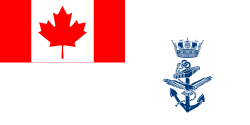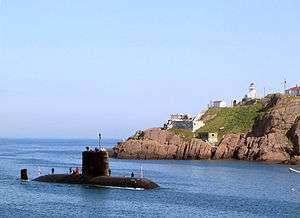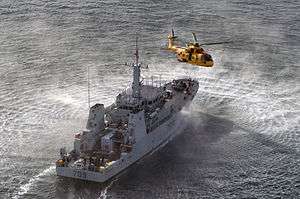Fleet of the Royal Canadian Navy

The Royal Canadian Navy (RCN) is tasked to provide maritime security along the Pacific, Atlantic and Arctic coasts of Canada, exercise Canada's sovereignty over the Arctic archipelago, and support Canada's multi-national and bilateral interests overseas. The RCN fleet comprises the Pacific Fleet at Canadian Forces Base (CFB) Esquimalt, and the Atlantic Fleet at CFB Halifax. CFB Esquimalt is located on Vancouver Island, in British Columbia, and is home to 15 vessels and 6,000 staff, the headquarters for Maritime Forces Pacific, Her Majesty's Canadian (HMC) Dockyard Esquimalt, Fleet Maintenance Facility – Cape Breton (FMF-CB), Fire Fighting and Damage Control School, the Naval Officer Training Centre (NOTC Venture), and extensive housing. CFB Halifax is home port for the 18 vessels of the Canadian Atlantic Fleet and situated in Halifax, Nova Scotia. CFB Halifax employs 7,000 civilians and military staff, and hosts the Canadian Atlantic Fleet headquarters, HMC Dockyard Halifax, FMF Cape Scott, extensive maritime research facilities, an ammunition depot, and the four maritime squadrons of the Royal Canadian Air Force that serve aboard the fleet.[1][2] The Canadian Forces are currently constructing a new naval facility at Nanisivik, Baffin Island, to provide a summer port for RCN patrols in the Canadian arctic.[3]
With the loss of command-and-control and resupply capabilities in 2015, the RCN is classified as a Rank 5 navy (offshore regional coastal defence) on the Todd-Lindberg classification system, dropping from Rank 3 (multiregional power projection).[4] In 2011, the government restored the traditional name of the Royal Canadian Navy, removed at the unification of the Canadian Forces in 1968. Commissioned vessels are designated as 'Her Majesty's Canadian Ship' (HMCS), minor ships as 'Parol Craft Training' (PCT) and auxiliaries as 'Canadian Forces Auxiliary Vessel' (CFAV).[5]
Destroyers

The Iroquois-class warships are helicopter-carrying, guided missile destroyers. Built for anti-submarine warfare, they were extensively modified for anti-aircraft defence with anti-air weapons systems, improved propulsion plants, advanced surface and sub-surface weapons and communications systems. HMCS Athabaskan, has a complement of 280, and is the last destroyer of this class to remain in service with the fleet.[6][7]
| Ship | Pennant | Armament | Displacement | Propulsion | Service | |||
|---|---|---|---|---|---|---|---|---|
| Builder | Laid down | Commissioned | Fleet | |||||
| HMCS Athabaskan | DDG 282 |
|
5100 t |
|
Davie Shipbuilding | 1 June 1969 | 30 September 1972 | Atlantic |
Frigates
_en_route_to_Haiti_2010-01-18.jpg)
The Halifax-class frigates are multi-role vessels with anti-submarine, anti-aircraft and anti-ship capability. In response to recent global security interests, the role of the class has shifted from open ocean to littoral engagement. Innovations in operational tactics have allowed the vessels of this class to adapt to new asymmetric surface threats. To ensure effective long-term capacity in this new threat environment the ships are undergoing a refit, including passive and active weapons, radars, and new combat architecture to meet the modern requirements. To date, seven of the 12 ships have been refitted. Each holds a compliment of 225 officers and crew. All ships of the class are named after major Canadian cities.[8][9]
| Ship | Pennant | Armament | Displacement | Propulsion | Service | |||
|---|---|---|---|---|---|---|---|---|
| Builder | Laid down | Commissioned | Fleet | |||||
| HMCS Halifax | FFH 330 |
|
|
|
Saint John Shipbuilding | 19 March 1987 | 29 June 1992 | Atlantic |
| HMCS Vancouver | FFH 331 | Saint John Shipbuilding | 19 May 1988 | 23 August 1993 | Pacific | |||
| HMCS Ville de Québec | FFH 332 | Davie Shipbuilding | 16 December 1988 | 14 July 1994 | Atlantic | |||
| HMCS Toronto | FFH 333 | Saint John Shipbuilding | 22 April 1989 | 29 July 1993 | Atlantic | |||
| HMCS Regina | FFH 334 | Davie Shipbuilding | 6 October 1989 | 29 December 1993 | Pacific | |||
| HMCS Calgary | FFH 335 | Davie Shipbuilding | 15 June 1991 | 12 May 1995 | Pacific | |||
| HMCS Montréal | FFH 336 | Saint John Shipbuilding | 8 February 1991 | 21 July 1994 | Atlantic | |||
| HMCS Fredericton | FFH 337 | Saint John Shipbuilding | 25 April 1992 | 10 September 1994 | Atlantic | |||
| HMCS Winnipeg | FFH 338 | Saint John Shipbuilding | 20 March 1993 | 23 June 1995 | Pacific | |||
| HMCS Charlottetown | FFH 339 | Saint John Shipbuilding | 18 December 1993 | 9 September 1995 | Atlantic | |||
| HMCS St. John's | FFH 340 | Saint John Shipbuilding | 24 August 1994 | 16 June 1996 | Atlantic | |||
| HMCS Ottawa | FFH 341 | Saint John Shipbuilding | 29 April 1995 | 28 September 1996 | Pacific | |||
Submarines

The Victoria class are diesel-electric fleet submarines designed in the late 1970s to supplement the Royal Navy's nuclear submarine force. They were decommissioned at the end of the Cold War. In 1998, Canada purchased the submarines to replace the aging Oberon-class submarines. Refit for Canadian service included the removal of Sub-Harpoon missile firing and mine-laying capabilities, installation of torpedo launch systems and upgrades to weapons and fire control systems. Each vessel holds 53 crew.[10]
| Ship | Pennant | Armament | Displacement | Propulsion | Service | |||
|---|---|---|---|---|---|---|---|---|
| Builder | Laid down | Commissioned | Fleet | |||||
| HMCS Victoria | SSK 876 |
|
|
|
Cammell Laird | 12 August 1987 | December 2000 | Pacific |
| HMCS Windsor | SSK 877 | Cammell Laird | 13 March 1990 | October 2003 | Atlantic | |||
| HMCS Corner Brook | SSK 878 | Cammell Laird | 10 January 1989 | March 2003 | Pacific | |||
| HMCS Chicoutimi | SSK 879 |
|
Vickers Shipbuilding and Engineering | February 1983 | September 2015 | Pacific | ||
Maritime coastal defence vessels

The Kingston-class coastal defence vessel are multi-role vessels built and launched from the mid- to late-1990s and are crewed by a combination of Naval Reserve and Regular-Force personnel. Each vessel displaces 970 t and runs with a compliment of between 31 and 47 officers and crew. Their main missions are counter narcotics, coastal surveillance, sovereignty patrol, route survey, and training. The ships capabilities include a mechanical minesweeping system, a route survey system, and a bottom object inspection vehicle.[11][12]
| Ship | Pennant | Armament | Displacement | Propulsion | Service | |||
|---|---|---|---|---|---|---|---|---|
| Builder | Laid down | Commissioned | Fleet | |||||
| HMCS Kingston | MM 700 |
|
970 t |
|
Halifax Shipyards | 12 December 1994 | 21 September 1996 | Atlantic |
| HMCS Glace Bay | MM 701 | Halifax Shipyards | 28 April 1995 | 26 October 1996 | Atlantic | |||
| HMCS Nanaimo | MM 702 | Halifax Shipyards | 11 August 1995 | 10 May 1997 | Pacific | |||
| HMCS Edmonton | MM 703 | Halifax Shipyards | 8 December 1995 | 21 June 1997 | Pacific | |||
| HMCS Shawinigan | MM 704 | Halifax Shipyards | 26 April 1996 | 14 June 1997 | Atlantic | |||
| HMCS Whitehorse | MM 705 | Halifax Shipyards | 26 July 1996 | 17 April 1998 | Pacific | |||
| HMCS Yellowknife | MM 706 | Halifax Shipyards | 7 November 1996 | 18 April 1998 | Pacific | |||
| HMCS Goose Bay | MM 707 | Halifax Shipyards | 22 February 1997 | 26 July 1998 | Atlantic | |||
| HMCS Moncton | MM 708 | Halifax Shipyards | 31 May 1997 | 12 July 1998 | Atlantic | |||
| HMCS Saskatoon | MM 709 | Halifax Shipyards | 5 September 1997 | 5 December 1998 | Pacific | |||
| HMCS Brandon | MM 710 | Halifax Shipyards | 6 December 1997 | 5 June 1999 | Pacific | |||
| HMCS Summerside | MM 711 | Halifax Shipyards | 28 March 1998 | 18 July 1999 | Atlantic | |||
Patrol craft training vessels

Orca-class ships are primarily used for one-to-six-week long 'at sea' naval officer training. Regular force Boatswains, Engineers and Naval communicators serve on these ships to train junior officers and non-commissioned sailors. They also patrol coastal waters for pollution infractions and fishing violations, and are frequently tasked for search and rescue operations. They operate year round in the coastal waters of British Columbia.[13][14]
| Name | Pennant number | Commissioned | Builder | Fleet |
|---|---|---|---|---|
| Orca | PCT 55 | 9 November 2006 | Victoria Shipyards | Pacific |
| Raven | PCT 56 | 15 Mar 2007 | Victoria Shipyards | Pacific |
| Caribou | PCT 57 | 31 Jul 2007 | Victoria Shipyards | Pacific |
| Renard | PCT 58 | 13 Sep 2007 | Victoria Shipyards | Pacific |
| Wolf | PCT 59 | 29 Nov 2007 | Victoria Shipyards | Pacific |
| Grizzly | PCT 60 | 19 Mar 2008 | Victoria Shipyards | Pacific |
| Cougar | PCT 61 | 2 Oct 2008 | Victoria Shipyards | Pacific |
| Moose | PCT 62 | 27 Nov 2008 | Victoria Shipyards | Pacific |
Support and auxiliary vessels

Sail training ship
- HMCS Oriole (KC 480)
Torpedo and sound ranging vessels
- CFAV Sikanni (YTP 611)
- CFAV Stikine (YTP 613)
Survey Ship
- CFAV Quest (AGOR 172)
Yard diving tenders
- Unnamed (YDT 11)
- CFAV Granby (YDT 12)
- CFAV Sechelt (YDT 610)
- CFAV Sooke (YDT 612)
Fireboats
- CFAV Firebird (YTR 561)
- CFAV Firebrand (YTR 562)
Tugboats
- CFAV Glendyne (YTB 640)
- CFAV Glendale (YTB 641)
- CFAV Glenevis (YTB 642)
- CFAV Glenbrook (YTB 643)
- CFAV Glenside (YTB 644)
- CFAV Tillicum (YTM 555)
- CFAV Lawrenceville (YTL 590)
- CFAV Parksville (YTL 591)
- CFAV Listerville (YTL 592)
- CFAV Merrickville (YTL 593)
- CFAV Marysville (YTL 594)
Yard auxiliary general
- CFAV Pelican (YAG 4)
- CFAV Gemini (YAG 650)
- CFAV Pegasus (YAG 651)
- CFAV Albatross (YAG 661)
- CFAV Black Duck (YAG 660)
Development and procurement

The RCN is undergoing a complex program of capacity expansion, ship life extension, modernization and fleet procurement. The Nanisivik Naval Facility currently under construction on Baffin Island in the arctic will provide shore services for fleet operations in the arctic during the four month summer season.[16][17] The National Shipbuilding Procurement Strategy will invest more than $30 billion into the development of Arctic capable patrol vessels, frigate-class surface warships, and long-range auxiliary supply vessels. Construction has begun on the 5–6 Harry DeWolf-class vessels under the Arctic Patrol Ship Project. The commercial containership MS Asterix is currently being converted into a fleet supply vessel, to meet operational requirements until the 2 new Queenston-class auxiliary vessels are completed.[18][19] While up to 15 warships of the Single Class Surface Combatant Project remain in the planning stages, the RCN is upgrading all current frigates with advanced systems and life extension maintenance to maximize operational capability into the 2030s.[20] In addition to the fleet component, the Canadian Armed Forces have begun replacing aging CH-124 Sea King helicopters serving in the RCN, with the CH-148 Cyclone. The first six Cyclones were delivered June 2015 [21][22] followed by a further two "Block 1.1" Cyclones in November/December 2015.
Key
| Displacement | Ship displacement at full load |
| Propulsion | Number of shafts, type of propulsion system, and top speed generated |
| Service | The dates work began and finished on the ship and its ultimate fate |
| Laid down | The date the keel began to be assembled |
| Launched | The date the ship was launched |
See also
- Royal Canadian Navy
- Origins of the Royal Canadian Navy
- History of the Royal Canadian Navy
- List of ships of the Royal Canadian Navy
- Hull classification symbol (Canada)
- Her Majesty's Canadian Ship
- List of aircraft of the Royal Canadian Navy
References
- ↑ Navy, Government of Canada, National Defence, Royal Canadian. "Royal Canadian Navy: Home". www.navy-marine.forces.gc.ca. Retrieved 2016-03-20.
- ↑ Gimblett, Richard. "Royal Canadian Navy". The Canadian Encyclopedia. Retrieved 2016-03-20.
- ↑ Bird, Michael (4 March 2015). "Making waves: The Navy's Arctic ambition revealed". The Globe and Mail. Retrieved 24 March 2015.
- ↑ Gilmore, Scott. "The Sinking of the Canadian Navy". Maclean's. Maclean's. Retrieved 16 August 2015.
- ↑ Navy, Government of Canada, National Defence, Royal Canadian. "Fleet & Units | Royal Canadian Navy". www.navy-marine.forces.gc.ca. Retrieved 2016-03-10.
- ↑ Navy, Government of Canada, National Defence, Royal Canadian. "Destroyers-Fleet & Units-Royal Canadian Navy". www.navy-marine.forces.gc.ca. Retrieved 2016-03-20.
- ↑ "Navy retires HMCS Algonquin, damaged in collision". Times Colonist. Canadian Press. 11 June 2015. Retrieved 27 June 2015.
- ↑ Navy, Government of Canada, National Defence, Royal Canadian. "Frigates / Fleet & Units / Royal Canadian Navy". www.navy-marine.forces.gc.ca. Retrieved 2016-03-20.
- ↑ "Halifax Class Frigates, Canada". Naval Technology. Kable. Retrieved 8 May 2015.
- ↑ Navy, Government of Canada, National Defence, Royal Canadian. "Submarines / Fleet & Units / Royal Canadian Navy". www.navy-marine.forces.gc.ca. Retrieved 2016-03-10.
- ↑ Navy, Government of Canada, National Defence, Royal Canadian. "Maritime Coastal Defence Vessels | Fleet & Units | Royal Canadian Navy". www.navy-marine.forces.gc.ca. Retrieved 2016-03-10.
- ↑ Saunders, Stephen (ed.) (2008). Jane's Fighting Ships 2008–2009. Jane's Fighting Ships (111th ed.). Surrey: Jane's Information Group. p. 95. ISBN 978-0-7106-2845-9. OCLC 225431774.
- ↑ "Fast tests keep new Canadian navy training ships on schedule". Diesel Progress North American Edition (April 2007).
- ↑ Navy, Government of Canada, National Defence, Royal Canadian. "Orca Class | Minor Vessels | Fleet & Units | Royal Canadian Navy". www.navy-marine.forces.gc.ca. Retrieved 2016-03-10.
- ↑ Macpherson, Ken (2002). The ships of Canada's naval forces 1910–2002. St. Catharines, Ontario: Vandall. ISBN 1-55125-072-1.
- ↑ Rogers, Sarah (6 March 2015). "Nanisivik naval fuel station postponed until 2018: National Defence". NunatsiaqOnline. Retrieved 24 March 2015.
- ↑ Bird, Michael (4 March 2015). "Making waves: The Navy's Arctic ambition revealed". The Globe and Mail. Retrieved 24 March 2015.
- ↑ Rosamond, Jon (4 October 2015). "Canada turns to Asterix for stop gap at-sea support". IHS Jane's 360. Retrieved 6 October 2015.
- ↑ Navy, Government of Canada, National Defence, Royal Canadian. "Joint Support Ship (JSS) | The Fleet | Royal Canadian Navy". www.navy-marine.forces.gc.ca. Retrieved 2016-03-10.
- ↑ Defence, Government of Canada, National. "National Defence | Canadian Armed Forces | Backgrounder | Halifax-Class Modernization (HCM) / Frigate Life Extension (FELEX)". www.forces.gc.ca. Retrieved 2016-03-10.
- ↑ Navy, Government of Canada, National Defence, Royal Canadian. "Royal Canadian Navy: Home". www.navy-marine.forces.gc.ca. Retrieved 2016-03-20.
- ↑ "Maritime Helicopter Project". National Defence and the Canadian Armed Forces. Government of Canada. Retrieved March 19, 2016.
Bibliography and further reading
- Blatherwick, F.J. (1992). Royal Canadian Navy Honours, Decorations, Medals, 1910–1968. FJB Air Publications, New Westminster.
- The Canadian Navy List 1914 to 1945. King's Printer, Ottawa.
- Colledge, J. J.; Warlow, Ben (2006) [1969]. Ships of the Royal Navy: The Complete Record of all Fighting Ships of the Royal Navy (Rev. ed.). London: Chatham Publishing. ISBN 978-1-86176-281-8. OCLC 67375475.
- Dittmar, F.J.; College, J.J. (1972). British Warships, 1914–1919. Alan, London.
- Douglas, W.A.B.; et al. (2004). No Higher Purpose: The Official Operational History of the Royal Canadian Navy in the Second World War, 1939–1943. Volume II, Part I. Vanwell, St. Catharines.
- Douglas, W.A.B.; et al. (2007). A Blue Water Navy: The Official Operational History of the Royal Canadian Navy in the Second World War – 1943–1945, Volume II, Part 2. Vanwell, St. Catharines.
- Gimblett, Richard H., ed. (2009). The Naval Service of Canada 1910–2010: The Centennial Story. Toronto: Dundurn Press. ISBN 978-1-4597-1322-2.
- Gimblett, Richard H.; Hadley, Michael L., eds. (2010). Citizen Sailors: Chronicles of Canada's Naval Reserve. Toronto: Dundurn Press. ISBN 978-1-55488-867-2.
- Johnston, William; Rawling, William G.P.; Gimblett, Richard H.; MacFarlane, John (2010). The Seabound Coast: The Official History of the Royal Canadian Navy, 1867–1939. 1. Toronto: Dundurn Press. ISBN 978-1-55488-908-2.
- Macpherson, Ken; Barrie, Ron (2002). The Ships of Canada's Naval Forces 1910–2002 (Third ed.). St. Catharines, Ontario: Vanwell Publishing. ISBN 1-55125-072-1.
- Milner, Marc (2010). Canada's Navy: The First Century (Second ed.). Toronto: University of Toronto Press. ISBN 978-0-8020-9604-3.
- Office of Naval Intelligence (1944). Index to Warships of the British Commonwealth (PDF). US Government Printing Office.
- Tucker, Gilbert (1952). The Naval Service of Canada: Its Official History. Vol 2: Activities on Shore During the Second World War. King's Printer, Ottawa.